![]()

![]()
In 1912, a decade and a half after Wilhelm Konrad Röntgen and Henri Becquerel discovered high energy radiation, Victor Hess found the ionization rate of background radiation increased roughly fourfold over the rate at ground level when he carried three electrometers to an altitude of 5300 meters in a free balloon flight. He concluded The results of my observation are best explained by the assumption that a radiation of very great penetrating power enters our atmosphere from above.
During 1913-14, Werner Kolhörster confirmed Victor Hess' results by measuring the increased ionization rate to an altitude of 9 km. Hess received the Nobel Prize in Physics in 1936 for his discovery.
79% of cosmic rays striking the Earth's atmosphere are high kinetic energy protons (H+1 = Hydrogen nuclei). About 15% are alpha particles (α = He+2 = Helium nuclei). The remainder is composed of other elementary particles and atomic nuclei roughly proportional to cosmic abundance and availability in interstellar gas clouds to be propelled by interactions with particles coming from the primary sources. A few relatively low energy cosmic rays are generated by solar flares. But most of the higher energy cosmic rays with typical energies of several billion electron volts (109 eV = 1 GeV), with diminishing abundance at least to energies of 1020 eV are believed to originate outside of our solar system. The solar wind attenuates the cosmic rays below 1010 eV from reaching Earth. The Earth's magnetic field further deflects the lower energy cosmic rays. The flux of 1011 eV cosmic rays is about 1 cosmic ray/m2/second. This diminishes to about 1 cosmic ray/m2/year for 1016 eV cosmic rays. At 1019 eV the flux is only 1 cosmic ray/km2/year. As visible on the graph below of the flux for higher energy cosmic rays, the decline in flux is not uniform but has several knee and ankle-like plateaus. (Also note the large uncertainty bars for the abundance of the highest energies.)
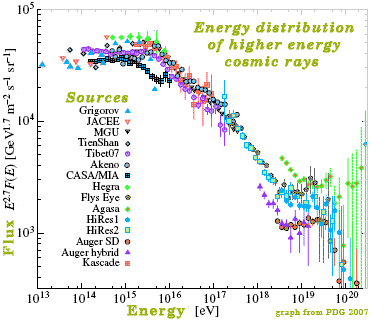 When these cosmic rays collide with nuclei of air molecules in the Earth's upper atmosphere, they create a shower of a large number of mesons, particularly pions (π). The intensity and spread of the shower depends on the energy of the original cosmic ray. These pions rapidly decay to more stable elementary particles. Electically neutral π0 decay with a half life of 8.4 x 10-8 second to mostly (99%) photons (γ = high energy light flashes) and (1% change to) electron-positron pairs (e-1 & e+1). Nearly all electrically charged π± decay with a half life of 2.6 x 10-8 second to muons (μ±) and neutrinos (ν).
When these cosmic rays collide with nuclei of air molecules in the Earth's upper atmosphere, they create a shower of a large number of mesons, particularly pions (π). The intensity and spread of the shower depends on the energy of the original cosmic ray. These pions rapidly decay to more stable elementary particles. Electically neutral π0 decay with a half life of 8.4 x 10-8 second to mostly (99%) photons (γ = high energy light flashes) and (1% change to) electron-positron pairs (e-1 & e+1). Nearly all electrically charged π± decay with a half life of 2.6 x 10-8 second to muons (μ±) and neutrinos (ν).
Each muon (mass 206 times that of an electron, 106 MeV) decays a hundred times more slowly (half life of 2.2 x 10-6 second) to an electron (e-1) and a pair of neutrinos (νμ & νe). While muons have only a short existance, their high speed near that of light and their minimal interaction with atoms in the air allows a portion of them to reach the surface of the earth. Since the muons are not absorbed by atoms, they penetrate buildings and pass through our bodies, brains and sense organs without any interaction which might allow our sense organs to detect them. Neutrinos are essentially conserved particles, and because they interact with matter much more rarely, they typically pass entirely through the earth without any possibility of being detected.
Scottish physicist Charles Thomson Rees Wilson (b1869, d1959), received half of the Nobel Prize for Physics in 1927 for developing of the expansion method for showing the tracks of electrically charged particles. Inspired by sightings of the Brocken spectre while working on the summit of Ben Nevis in 1894, Wilson began developing expansion chambers for studying cloud formation in moist air. While doing so, he discovered that ions could act as centers for water droplet formation. Realizing the potential use for tracking recently discovered high energy ionizing radiation, Wilson perfected the cloud chamber by 1911. Along with the electronic counter developed by Hans Geiger, the Wilson cloud chamber because one of primary tools of early high energy physics.
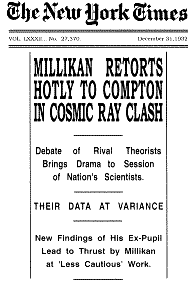 While watching the tracks of cosmic ray particles passing through a cloud chamber in 1932, Carl David Anderson (b1905, d1991) was the first to see antimatter, an anti-electron (later called the positron, ), e+1, which had been predicted in 1928 by Paul Dirac (b1902, d1984). A positron is a matter wave exactly the inverse of an electron, with most of the same characteristics, but an opposite, positive electric charge. When a positron and electron spontaneously combine, they annihilate leaving nothing but a pair of gamma rays (high energy photons of light) to conserve momentum and energy. Dirac shared the Nobel Prize in Physics for 1933 and Anderson shared the Nobel Prize in Physics for 1936.
While watching the tracks of cosmic ray particles passing through a cloud chamber in 1932, Carl David Anderson (b1905, d1991) was the first to see antimatter, an anti-electron (later called the positron, ), e+1, which had been predicted in 1928 by Paul Dirac (b1902, d1984). A positron is a matter wave exactly the inverse of an electron, with most of the same characteristics, but an opposite, positive electric charge. When a positron and electron spontaneously combine, they annihilate leaving nothing but a pair of gamma rays (high energy photons of light) to conserve momentum and energy. Dirac shared the Nobel Prize in Physics for 1933 and Anderson shared the Nobel Prize in Physics for 1936.
A debate soon raged over the nature of cosmic rays. According to Anderson's mentor, Robert Millikan, they were gamma rays from space, hence Millikan coined the name cosmic rays. But evidence was soon gathered that most of the cosmic rays being detected were still different particles. By 1936 Carl Anderson had evidence that cosmic rays included a new kind of elementary particle with many of the properties of the electron. But it was deflected less by a magnetic field suggesting it has a mass roughly 200 times greater. First called a meson for having a mass midway between that of an electron and a proton, then later called the mu meson when other mid-weight particles were discovered, it is now known as a muon, μ, totally distinct from other mesons.
But before the discovery of muons, Bruno Rossi reported in 1934 an observation of near-simultaneous discharges of two Geiger counters widely separated horizontally during a test of equipment he was using in a measurement of the east-west effect (more cosmic rays come to Earth from the West than from the East). Rossi wrote ...it seems that once in a while the recording equipment is struck by very extensive showers of particles, which causes coincidences between the counters, even placed at large distances from one another.
Lacking sufficient time, Rossi was unable to study this phenomenon more closely. Unaware of Rossi's earlier report, Pierre Auger in 1938 positioned particle detectors high in the Alps and subsequently noticed that two detectors located many meters apart both detected the arrival of particles at the same time. Auger concluded that he had observed showers with energies of 1015 eV (107 times more energetic than any previously measured cosmic rays), apparently generated by high-energy primary cosmic-ray particles that interact with air nuclei high in the atmosphere, ultimately yielding a shower of electrons, photons, and the newly discovered muons reaching ground level.
Indian Homi J. Bhabha (b1909, d1966 by airliner crash) derived an expression for the probability of scattering positrons by electrons, a process now known as Bhabha scattering. His classic paper, jointly published with Warren Heitler in 1937, described how primary cosmic rays from space might interact with the upper atmosphere to produce particles observed at the ground level. Bhabha and Heitler explained the physics and mathematics of cosmic ray shower formation by the cascade production of gamma rays and positive and negative electron pairs. Bhabha had been actively developing India's nuclear bomb at the time of the 707 flying into Mont Blanc.
So to summarize the conceivable ways of detecting cosmic rays at ground level are the following: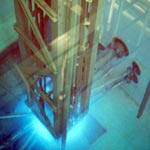
There are a few simple experiments you can do. And there are some very complex experiments currently underway that you can learn about and even possibly contribute some efforts to help accomplish:
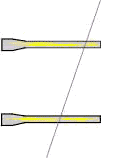
Little is known about the most energetic cosmic rays. Because of their high energies, their showers might extend over areas larger than cities. So collaborative efforts recording precise detection times and locations might significantly contribute to the understanding of cosmic rays.
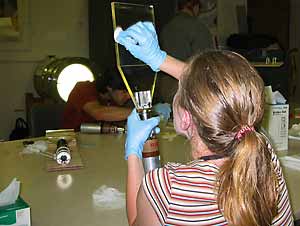 To study cosmic rays, a collaboration of high school students and teachers has been formed, coordinated by scientists at a number of U.S. national laboratories and research centers, administered by FermiLab. Groups of physics teachers constructed cosmic ray detectors at several national laboratories (including the author who worked at SLAC). The detectors have been loaned to schools around the United States for student use. Several additional detectors have been assembled in other countries as well. One is shown at right → being cleaned before receiving its light blocking covering. Description of the construction at SLAC is described in some detail accompanied by many photographs.
To study cosmic rays, a collaboration of high school students and teachers has been formed, coordinated by scientists at a number of U.S. national laboratories and research centers, administered by FermiLab. Groups of physics teachers constructed cosmic ray detectors at several national laboratories (including the author who worked at SLAC). The detectors have been loaned to schools around the United States for student use. Several additional detectors have been assembled in other countries as well. One is shown at right → being cleaned before receiving its light blocking covering. Description of the construction at SLAC is described in some detail accompanied by many photographs.Other experiments are also being planned The overview of QuarkNet can be accessed at the QuarkNet Index page.
![]()
to QuarkNet Cosmic Ray eLab
to virtual QuarkNet resources page
to ie-Physics menu